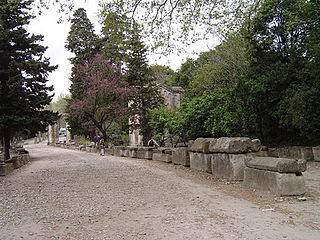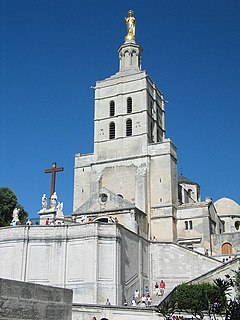
A World Heritage Site is a landmark or area with legal protection by an international convention administered by the United Nations Educational, Scientific and Cultural Organization (UNESCO). World Heritage Sites are designated by UNESCO for having cultural, historical, scientific or other form of significance. The sites are judged to contain "cultural and natural heritage around the world considered to be of outstanding value to humanity".

Arles is a coastal city and commune in the South of France, a subprefecture in the Bouches-du-Rhône department of the Provence-Alpes-Côte d'Azur region, in the former province of Provence.

Epidaurus was a small city (polis) in ancient Greece, on the Argolid Peninsula at the Saronic Gulf. Two modern towns bear the name Epidavros: Palaia Epidavros and Nea Epidavros. Since 2010 they belong to the new municipality of Epidaurus, part of the regional unit of Argolis. The seat of the municipality is the town Lygourio. The nearby sanctuary and ancient theatre were inscribed on the UNESCO World Heritage List in 1988 because of their exemplary architecture and importance in the development and spread of healing sanctuaries and cults across the ancient Greek and Roman worlds.

Saint-Émilion is a commune in the Gironde department in Nouvelle-Aquitaine in southwestern France. In 2016, it had a population of 1,938.

Tourism in Croatia is a major industry of country's economy, accounting for almost 20% of gross domestic product (GDP) as of 2021.

In Ancient Roman architecture a cryptoporticus is a covered corridor or passageway. The usual English is "cryptoportico". The cryptoportico is a semi-subterranean gallery whose vaulting supports portico structures aboveground and which is lit from openings at the tops of its arches.

The Church of St. Trophime (Trophimus) is a Roman Catholic church and former cathedral located in the city of Arles, in the Bouches-du-Rhône Department of southern France. It was built between the 12th century and the 15th century, and is in the Romanesque architectural tradition. The sculptures over the church's portal, particularly the Last Judgement, and the columns in the adjacent cloister, are considered some of the finest examples of Romanesque sculpture.

The Alyscamps is a large Roman necropolis, which is a short distance outside the walls of the old town of Arles, France. It was one of the most famous necropolises of the ancient world. The name comes from the Provençal Occitan word Aliscamps, which comes from the Latin Elisii Campi. They were famous in the Middle Ages and are referred to by Ariosto in Orlando Furioso and by Dante in the Inferno.

The Arles Amphitheatre is a Roman amphitheatre in the southern French town of Arles. Two-tiered, it is probably the most prominent tourist attraction in the city which thrived in Ancient Rome. The towers jutting out from the top are medieval add-ons.

Avignon Cathedral is a Roman Catholic church located next to the Palais des Papes in Avignon, France. The cathedral is the seat of the Archbishop of Avignon.

The Basilica of Saint-Martin d'Ainay is a Romanesque church in Ainay in the Presqu'île district in the historic centre of Lyon, France. A quintessential example of Romanesque architecture, it was inscribed on the UNESCO World Heritage List along with other notable buildings in the centre of Lyon as a testimony to Lyon's long history as an important European town and unique blend of architectural styles.

The Obélisque d'Arles is a 4th-century Roman obelisk, erected in the center of the Place de la République, in front of the town hall of Arles, France.

Arles, Roman and Romanesque Monuments is an area containing a collection of monuments in the city centre of Arles, France, that has been listed as a UNESCO World Heritage Site since 1981.

The Odeon of Lyon is a small ancient Roman theatre near the summit of the Fourvière hill in Lyon, France. It forms a pair with the Ancient Theatre of Fourvière, one of only two such pairs in Gaul. Along with other buildings in Lyon, it was inscribed on the UNESCO World Heritage List in 1998, protecting Lyon's long history as a powerful city and its unique architecture.

The Manécanterie is an ancient monument situated in Lyon in Saint Jean district, in the 5th arrondissement of Lyon. It is placed side by side to the south southwest of the cathedral Saint Jean and is a part of the former convent of the cathedral. This small Romanesque building served first as dining hall to the canons of Saint Jean, before becoming a parish choir school, namely a school for the singing of the clergy. In 1998, it was inscribed on the UNESCO World Heritage List along with other notable buildings in historic Lyon as a testimony to Lyon's long history and unique architecture.

Museon Arlaten is a museum dedicated to the ethnography of Provence. It is located in Arles, at 29, rue de la République, and it is housed in the 15th century Hôtel particulier Laval-Castellane, now a monument historique.
















